
Download a larger image by clicking on any picture below. The video frames link to relatively small pictures.
Chase the Union Pacific Challenger class 4-6-6-4 steam locomotive 3985 from Pomona through Cajon Pass and Victorville to Yermo on August 20, 2000.
I was on the road before 6:00 A.M. on Sunday August 20 to catch the Union Pacific Challenger steam locomotive No. 3985. The Challenger class of locomotive has two sets of six drive wheels. The front set of wheels is articulated to allow the engine to negotiate relatively small radius turns. No. 3895 is the largest steam engine still operating in the U.S. It was built by the American Locomotive Company in 1943. It was retired from revenue service in 1957.
It was still dark as I gassed up the 4Runner for the drive ahead. The sun came up directly in front of me as I reached Santa Paula. It reflected very brightly from the hood of the 4Runner. I stopped in Fillmore for a pit stop and a bite to eat.
The train was scheduled to leave Union Station in L. A. at 8:00 A.M. I was just at Pasadena on the 210 about then. I turned south on the 57 and then took the Corona Expressway off ramp. The expressway crossed the Union Pacific Railroad tracks just before I got to 2nd street, where I turned left. I turned left again to reach 1st street, which runs adjacent to the tracks. I parked just to the east of Hamilton so that I could get the crossing gate, lights, and bells of the at-grade crossing on the video as the Challenger crossed the intersection.
I had well over an hour to wait for the train. While we waited, a very slow west bound Santa Fe freight train blasted its horn several times and clanged its bell as it approached Hamilton. It triggered the crossing gates and lights as it pulled its load of containers through the intersection and stopped, blocking the road for several minutes. I could not understand why people sat patiently at the intersection instead of taking the frontage road one block over to get around the front of the train. Eventually, the train continued slowly on its way. Then a fast east bound Union Pacific train of great length, loaded double-height with red containers, roared past. A short while later, it was followed by another very slow, west bound freight train.
At ten minutes to ten, while the freight train was crawling through the intersection, the smoke from the Challenger appeared to the west. I started the camcorder recording and stepped away from the tripod to shoot still pictures. The Challenger blew a couple of long notes on its whistle as it approached the intersection at very high speed. The smoke trailed back straight from the smokestack.
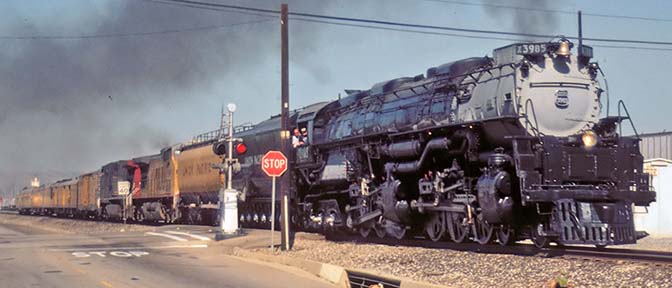 Union Pacific Challenger No. 3985
crossing Hamilton Street in Pomona.
Union Pacific Challenger No. 3985
crossing Hamilton Street in Pomona.
 Union Pacific Challenger No. 3985
crossing Hamilton Street in Pomona.
Union Pacific Challenger No. 3985
crossing Hamilton Street in Pomona.
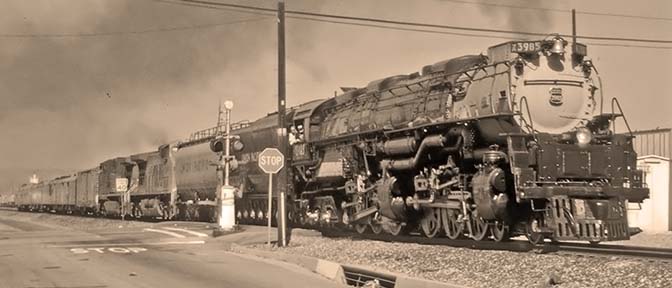 Union Pacific Challenger No. 3985
crossing Hamilton Street in Pomona.
Union Pacific Challenger No. 3985
crossing Hamilton Street in Pomona.
Behind the black and gray locomotive was a black centipede tender with a four-wheeled truck at the front and ten wheels fixed to its frame. The first tender was followed by a yellow tender with two six-wheeled bogies. Two diesel locomotives were assisting the Challenger. They were pulling a string of yellow Union Pacific Pullman cars, with a dome car at the rear end.
Once the train had passed, I pulled the video camera off the tripod and threw my gear back into the 4Runner. I made my way north to I-10 to leapfrog the train up to the bend on the Cajon Grade. I got off of I-15 at the Pearblossom Highway and crossed over to the two pairs of railroad tracks.
I found my down to a dirt road running alongside the outermost of the tracks leading to Barstow. The tracks leading to Bakersfield were above me. Two sets of southbound tracks were below me. I passed a parked eighteen-wheeler and pulled up to a yellow jeep. A man had brought his son to watch the steam engine. I asked him if I was on the right track. He said that the Challenger had used that track on its prior visit.
I continued a short distance up the road to a pullout adjacent to a sweeping left curve in the track. I could see the track from where it crossed underneath the Pearblossom highway below. After passing under the bridge, the tracks made a right turn into a straight section. I positioned the video camera to look straight down the straight section. Then the tracks entered the sweeping left turn, disappearing behind another sandstone bluff at the other end. The tracks turned back to the right for the rest of the big bend in the grade.
It had taken me forty minutes to get to the pass from my first stop. At that time, the train was paying a protracted visit to the San Bernardino train station. I had a wait of an hour and a half before it arrived at the grade.
 Yours truly waiting for Union
Pacific Challenger No. 3985. I thought I had turned the video
camera off.
Yours truly waiting for Union
Pacific Challenger No. 3985. I thought I had turned the video
camera off.
During that time another railroad enthusiast in a purple shirt walked up from the parked eighteen-wheeler. He was a talkative railroad buff, with a comment about just about everything that he saw. I convinced him to stand some distance away while I was shooting video of the Challenger. While we waited a pair of south bound Burlington Northern Santa Fe freight trains slowly descended the grade on the tracks below us. Then a Santa Fe freight came up the track that we were waiting next to. It allowed me to determine where the Challenger would become visible and gave me an opportunity to practice the panning and zooming that I would do as the steam engine went by.
Finally, the Challenger appeared from behind a sandstone bluff. It disappeared behind another hill, and I lined up the video camera on the Pearblossom Highway overpass. I followed the Challenger through the first turn with the video camera. I grabbed the Nikon, shot a few still frames through the 400mm telephoto and then switched to the wide-angle zoom lens. I zoomed back with the video camera and framed the entry into the sweeping left turn. I picked off several still frames as the locomotive chugged by.
 Union Pacific Challenger No. 3985
ascending the Cajon Grade
Union Pacific Challenger No. 3985
ascending the Cajon Grade
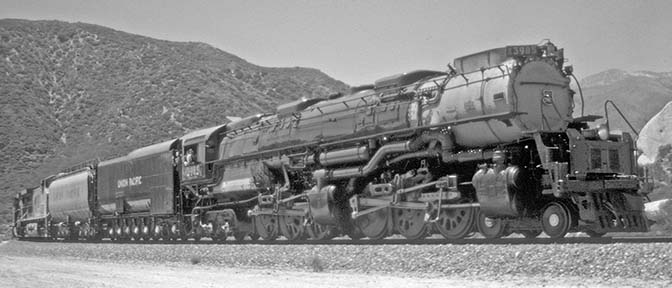 Union Pacific Challenger No. 3985
ascending the Cajon Grade
Union Pacific Challenger No. 3985
ascending the Cajon Grade
Union Pacific Challenger No. 3985, Cajon Grade, August 20, 2000: This photograph is available as prints up to 13-3/8" x 20". It is also available as Greeting Cards, Throw Pillows, Duvet Covers, Tote Bags, Shower Curtains, and Phone Cases.
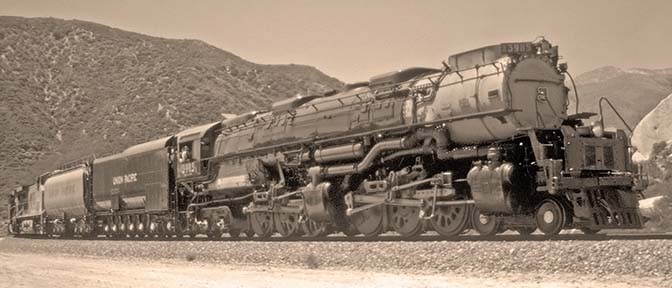 Union Pacific Challenger No. 3985
ascending the Cajon Grade
Union Pacific Challenger No. 3985
ascending the Cajon Grade
Union Pacific Challenger No. 3985, Cajon Grade, August 20, 2000 Sepia: This photograph is available as prints up to 13-3/8" x 20". It is also available as Greeting Cards, Throw Pillows, Duvet Covers, Tote Bags, Shower Curtains, and Phone Cases.
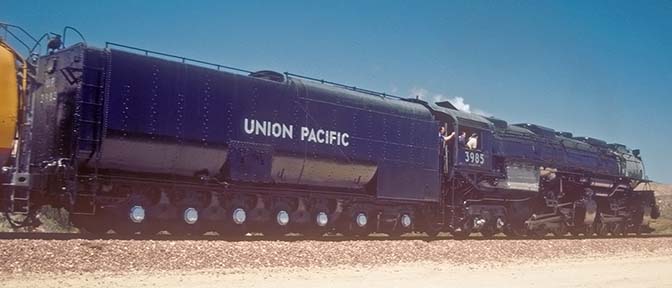 Union Pacific Challenger No. 3985
ascending the Cajon Grade.
Union Pacific Challenger No. 3985
ascending the Cajon Grade.
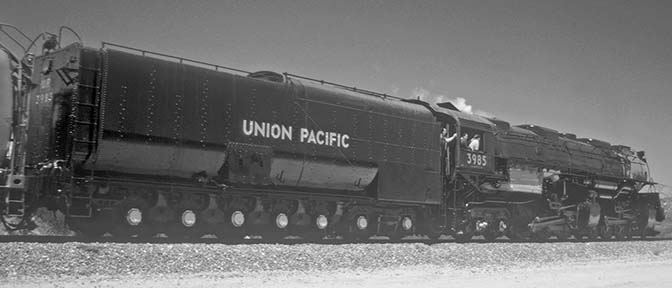 Union Pacific Challenger No. 3985
ascending the Cajon Grade.
Union Pacific Challenger No. 3985
ascending the Cajon Grade.
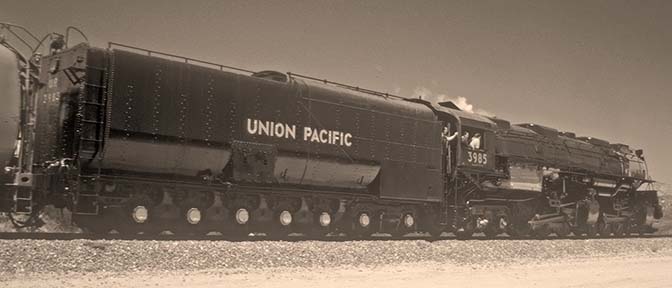 Union Pacific Challenger No. 3985
ascending the Cajon Grade.
Union Pacific Challenger No. 3985
ascending the Cajon Grade.
I grabbed the handle of the tripod and steered the video camera around to shoot the train receding around the turn. I clicked off more still frames as the train disappeared behind the ridge.
 Union Pacific Challenger No. 3985 on the Cajon
Grade. (from video)
Union Pacific Challenger No. 3985 on the Cajon
Grade. (from video)
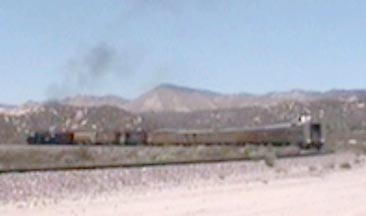 Union Pacific Challenger No. 3985. (from video)
Union Pacific Challenger No. 3985. (from video)
I lined the video camera up on another gap and then shot some more telephoto frames. Once the train had gone from view, I packed up and rushed away.
I thought that the train might stop at Summit at the top of the grade. I followed three pickup trucks up the road to Summit. I could see the rear end of the train a couple of times, but the Challenger beat us to Summit and did not stop there. A large number of cars were parked, some very stupidly, along and in the road. Having seen the train go by, people were moving back to their cars as we drove past.
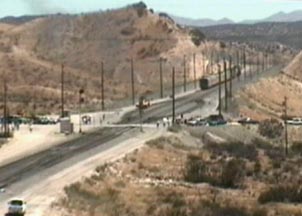 Union Pacific Challenger No. 3985 speeding
through Summit. (from video)
Union Pacific Challenger No. 3985 speeding
through Summit. (from video)
There were already many cars on the road ahead of me as we chased the train up Summit Valley to Santa Fe Road. I could see the train ahead of me, but the traffic prevented me from catching up to it. Along the road, people were just packing up their cameras following the passage of the stream engine.
It was necessary to cross over the railroad tracks to get to the road that goes to the Victorville Railroad Station. That involved three right turns stuck in the line of cars of people leaving the side of the tracks to get on the overpass. Once over the overpass it was necessary to make another two rights and a left to get on Hesperia Road headed toward the railroad station. I had completely lost the train by then.
The Challenger was billowing black smoke as it sat in the station with a mass of enthusiasts milling about. All the parking places at the station were occupied, as were all available parking spots on the street. I continued past the station for about a quarter mile until I saw a likely looking shooting location next to the tracks. I made a u-turn and parked across the street from the tracks. I grabbed the cameras and crossed the street.
I set up the tripod looking down a long straightaway to where the Challenger stood in the station. The track turned to the right just before it got to my location. I could see a long way down the straight section of track leading away from the station on the other side. It was not a long wait for the train to leave the station.
The Challenger chuffed toward us. I followed it with the video camera up to the turn and then switched to the still camera as it came by us and rounded the turn.
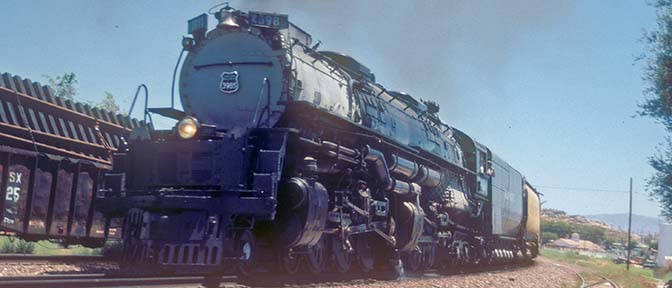 Union Pacific Challenger No. 3985
departs Victorville Railroad Station.
Union Pacific Challenger No. 3985
departs Victorville Railroad Station.
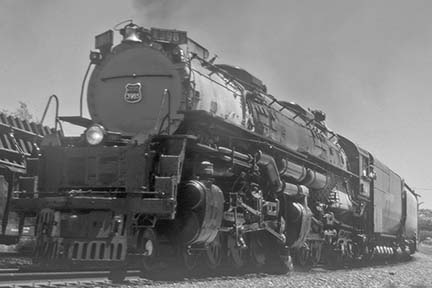 Union Pacific Challenger No. 3985
departs Victorville Railroad Station.
Union Pacific Challenger No. 3985
departs Victorville Railroad Station.
 Union Pacific Challenger No. 3985
departs Victorville Railroad Station.
Union Pacific Challenger No. 3985
departs Victorville Railroad Station.
I swung the video camera around to get a shot of the train receded. Its image was blurred and wavering because of the heat induced atmospheric turbulence.
 Union Pacific Challenger No. 3985
leaving Victorville. (from video)
Union Pacific Challenger No. 3985
leaving Victorville. (from video)
I grabbed the gear and made my way across the street against the stream of traffic coming out of the train station.
At this point I was faced with a choice. I could get on the I-15 and leapfrog the train to Barstow, or I could follow it up the National Trails Highway in the hopes of getting in front of it again. I decided to chase the train.
The train had gained some distance on me. Enough time elapsed after it passed for people to get in their cars and pull out onto the highway to follow the train ahead of me. The leader of the chase would not pass the train, so the line of cars just piled up behind. I could see the train ahead of me, but there was no way to gain on it.
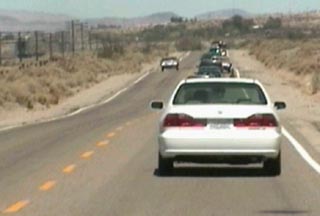 Union Pacific Challenger No. 3985
can be seen in the distance at the left. (from video)
Union Pacific Challenger No. 3985
can be seen in the distance at the left. (from video)
After many miles of frustrating chase, the tracks veered away from the road.
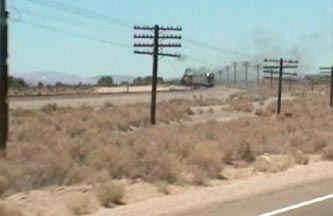 Union Pacific Challenger No. 3985
from the National Trails Highway. (from video)
Union Pacific Challenger No. 3985
from the National Trails Highway. (from video)
 Union Pacific Challenger No. 3985
from the National Trails Highway. (from video)
Union Pacific Challenger No. 3985
from the National Trails Highway. (from video)
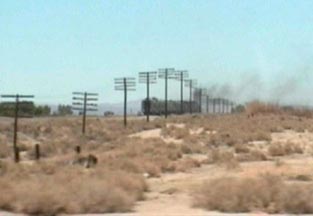 Union Pacific Challenger No. 3985
from the National Trails Highway. (from video)
Union Pacific Challenger No. 3985
from the National Trails Highway. (from video)
I took the next left turn, Hinkley Road. I wasn't sure if it would go anywhere near the tracks, but I had to get away from the traffic. The train had just gone by when I reached the railroad crossing, but the gate didn't go up and the lights and bells just kept going. Suddenly a long freight train appeared from the right and spent a few minutes crossing in front of me.
 Railroad crossing at Hinkley Road.
(from video)
Railroad crossing at Hinkley Road.
(from video)
After it passed, I turned right onto the dirt road that fronted the tracks. I passed the same yellow jeep that I had seen back at the Cajon Grade and raced after the train. I was actually going a bit faster than I had been on the paved road.
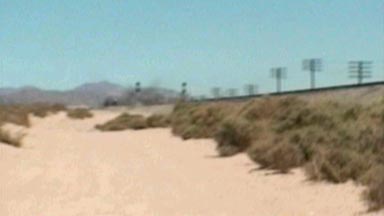 The smoke from Union Pacific
Challenger No. 3985 can be seen in the distance. (from video)
The smoke from Union Pacific
Challenger No. 3985 can be seen in the distance. (from video)
I gained but slowly on the train until I came to the overpass of the Highway 58 interchange.
I dropped down from the frontage road to the paved road and crossed under the railroad. I gave up on the chase and decided to drive directly to Yermo, the destination of the train. Yermo is about 10 miles east of Barstow near the artificial ghost town of Calico. I pulled off the I-15 at Yermo, wondering where they would take the train. I turned left and drove through the little burg. On the east end of the rail yard, I found a road that crossed the tracks and led back to the west. I followed it to a parking lot where people were gathering for the arrival of the train.
I decided that I would prefer to shoot video of the Challenger as it entered the train yard, so I continued driving west. I found a crossing at the west end of the yard and parked. It was so hot that I left the engine running to power the air conditioner while I waited for the train.
It wasn't long before the smoke from the Challenger could be seen over the scrub brush in the distance. The glare of the sun on the tracks shimmered in the heat as the chugging of the train grew louder. It pulled a couple of long notes on its whistle as it neared the crossing and slowly rolled by.
 Union Pacific Challenger No. 3985
entering the Yermo rail yard.
Union Pacific Challenger No. 3985
entering the Yermo rail yard.
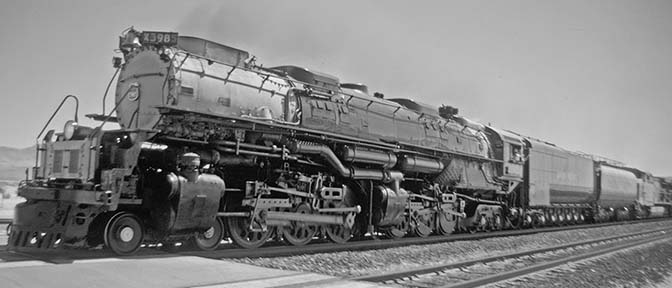 Union Pacific Challenger No. 3985 entering the Yermo rail yard.
Union Pacific Challenger No. 3985 entering the Yermo rail yard.
Union Pacific Challenger No. 3985, Yermo, August 20, 2000 Sepia: This photograph is available as prints up to 13-3/8" x 20". It is also available as Greeting Cards, Throw Pillows, Duvet Covers, Tote Bags, Shower Curtains, and Phone Cases.
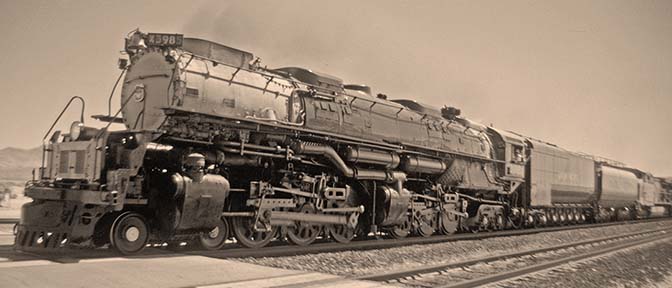 Union Pacific Challenger No. 3985
entering the Yermo rail yard.
Union Pacific Challenger No. 3985
entering the Yermo rail yard.
Union Pacific Challenger No. 3985, Yermo, August 20, 2000 Grayscale: This photograph is available as prints up to 13-3/8" x 20". It is also available as Greeting Cards, Throw Pillows, Duvet Covers, Tote Bags, Shower Curtains, and Phone Cases.
The switches were set to guide it to the northernmost track of the yard. It pulled into the station and slowed to a halt with its plume of black smoke towering above it.
 Union Pacific Challenger No. 3985 pulling into
the Yermo Station. (from video)
Union Pacific Challenger No. 3985 pulling into
the Yermo Station. (from video)
I packed up the camera gear and drove back around the rail yard. The crowd was still waiting on the south side of the tracks, on the far side of the yard from where the locomotive stood. I continued around to the north side of the yard to see the Challenger close up.
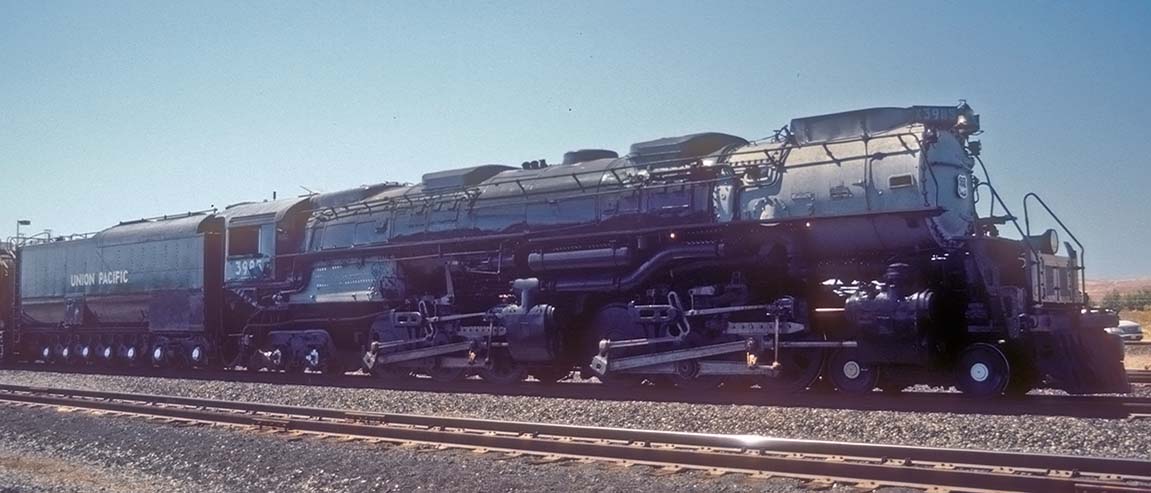 There was a much smaller crowd
standing around the steam engine as it hissed, spewed steam from
various orifices, and radiated heat. I shot several video takes
and many still photographs from both sides of the train.
There was a much smaller crowd
standing around the steam engine as it hissed, spewed steam from
various orifices, and radiated heat. I shot several video takes
and many still photographs from both sides of the train.
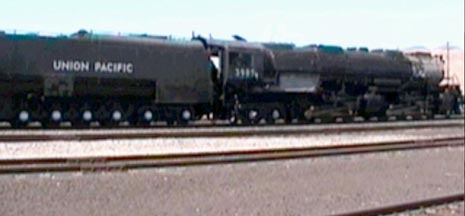 Union Pacific Challenger No. 3985. (from video)
Union Pacific Challenger No. 3985. (from video)
After a while, the engineer tooted the whistle a couple of times. Then he vented a great quantity of steam from ports around the drive wheels and started the train rolling forward.
 Union Pacific Challenger No. 3985 rolled
forward several yards and then halted for a while before
departing from the vicinity of the station. I hit the fade-out
button to close the video on the departing dome car. (from video)
Union Pacific Challenger No. 3985 rolled
forward several yards and then halted for a while before
departing from the vicinity of the station. I hit the fade-out
button to close the video on the departing dome car. (from video)
I got in my car and started back to the freeway to head home, but there was a tower of black smoke coming from the locomotive, which had stopped near the east end of the yard. I pulled off the road and parked again. After a little bit, the train started up once again, leaving the crowd wondering where it was off to.
 Union Pacific Challenger No. 3985 was supposed
to be staying overnight in Yermo. (from video)
Union Pacific Challenger No. 3985 was supposed
to be staying overnight in Yermo. (from video)
I had the impression that the train was maneuvering to back into the track on the south side of the yard where everyone had been waiting for it. I drove across the tracks and a short distance to the east of the yard. Indeed, the train was slowly backing up. The switches were set to guide it onto the southernmost track in the yard.
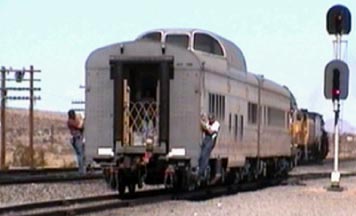 On each side of the dome car, a crewmember was
hanging out from the side of the train to watch out for
unobservant train enthusiasts. (from video)
On each side of the dome car, a crewmember was
hanging out from the side of the train to watch out for
unobservant train enthusiasts. (from video)
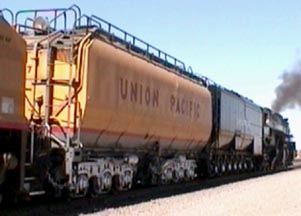 Union Pacific Challenger No. 3985 is equipped
with two tenders. (from video)
Union Pacific Challenger No. 3985 is equipped
with two tenders. (from video)
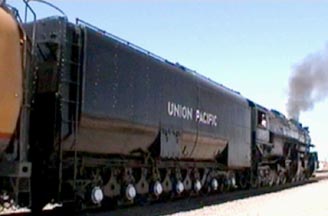 The forward tender is a centipede. It has a
four-wheeled truck in the front and five pairs of wheels fixed to
its frame. It puts a lot of stress on the rails in tight turns.
(from video)
The forward tender is a centipede. It has a
four-wheeled truck in the front and five pairs of wheels fixed to
its frame. It puts a lot of stress on the rails in tight turns.
(from video)
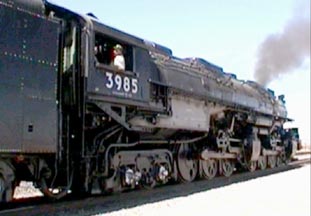 Union Pacific Challenger No. 3985. (from video)
Union Pacific Challenger No. 3985. (from video)
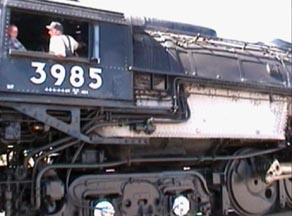 The engineer is looking to the rear as he backs
up the train. (from video)
The engineer is looking to the rear as he backs
up the train. (from video)
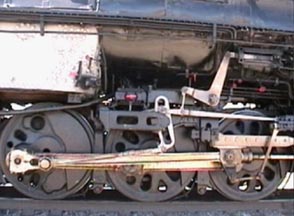 The rear set of driving wheels. (from video)
The rear set of driving wheels. (from video)
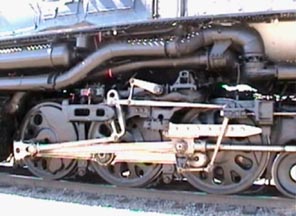 The forward set of driving wheels. (from video)
The forward set of driving wheels. (from video)
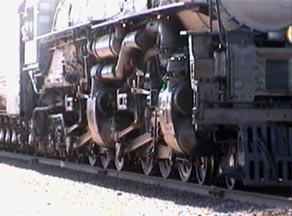 Union Pacific Challenger No. 3985 is a 4-6-6-4.
(from video)
Union Pacific Challenger No. 3985 is a 4-6-6-4.
(from video)
 As I watched Union Pacific Challenger No. 3985
backing away, I concluded that I had had quite enough train
chasing for the day. It was after 4:00 P.M., and I was still 250
miles from home. (from video)
As I watched Union Pacific Challenger No. 3985
backing away, I concluded that I had had quite enough train
chasing for the day. It was after 4:00 P.M., and I was still 250
miles from home. (from video)
![]() The Union Pacific Railroad maintains Challenger No. 3985 in Wyoming.
The Union Pacific Railroad maintains Challenger No. 3985 in Wyoming.
You can buy a 2020 Calendar featuring my photographs of steam locomotives.
Steam locomotives photographed in Arizona, California, and Colorado include:
Eureka Skunk Train Baldwin 2-8-2 #45,
Fillmore & Western Sespe 0-4-0 #1,
Fillmore & Western 2-8-0 #51,
Durango-Silverton Narrow-gauge K-28 2-8-2 #478,
Sierra Lima Shay No 2,
Santa Fe Baldwin Northern 4-8-4 #3751,
Union Pacific American Challenger 4-6-6-4 #3985,
Grand Canyon Baldwin Mikado 2-8-2 #4960,
Union Pacific American FEF-3 4-8-4 #844
Union Pacific Big Boy 4-8-8-4 #4014.
 Put a copy of the Steam Locomotives 2020 Calendar in your Lulu.com shopping cart for $14.95.
Put a copy of the Steam Locomotives 2020 Calendar in your Lulu.com shopping cart for $14.95.
You can buy a 2020 Calendar featuring my photographs of Union Pacific Big Boy Steam Locomotive 4014 in Arizona in Arizona on October 16, 2019.
A dozen pictures of Union Pacific Big Boy Steam Locomotive 4014 in Tacna, Aztec, Gila Bend, and the Maricopa Hills.
 Put a copy of the Union Pacific Big Boy Steam Locomotive 4014 in Arizona 2020 Calendar in your Lulu.com shopping cart for $14.95.
Put a copy of the Union Pacific Big Boy Steam Locomotive 4014 in Arizona 2020 Calendar in your Lulu.com shopping cart for $14.95.
You can buy a 2020 Calendar featuring my photographs of Union Pacific Steam Locomotive 844 pulling the Grand Canyon State Steam Special in Arizona on November 12 and 15, 2011.
A dozen pictures of Union Pacific Steam Locomotive 844 in Gilbert, Tempe, Coolidge, Picacho, and the Maricopa Mountains.
 Put a copy of the Union Pacific Steam Locomotive 844 in Arizona 2020 Calendar in your Lulu.com shopping cart for $14.95.
Put a copy of the Union Pacific Steam Locomotive 844 in Arizona 2020 Calendar in your Lulu.com shopping cart for $14.95.
 More of my Vintage Locomotive and Rail Car photographs.
More of my Vintage Locomotive and Rail Car photographs.
Send a message to Brian